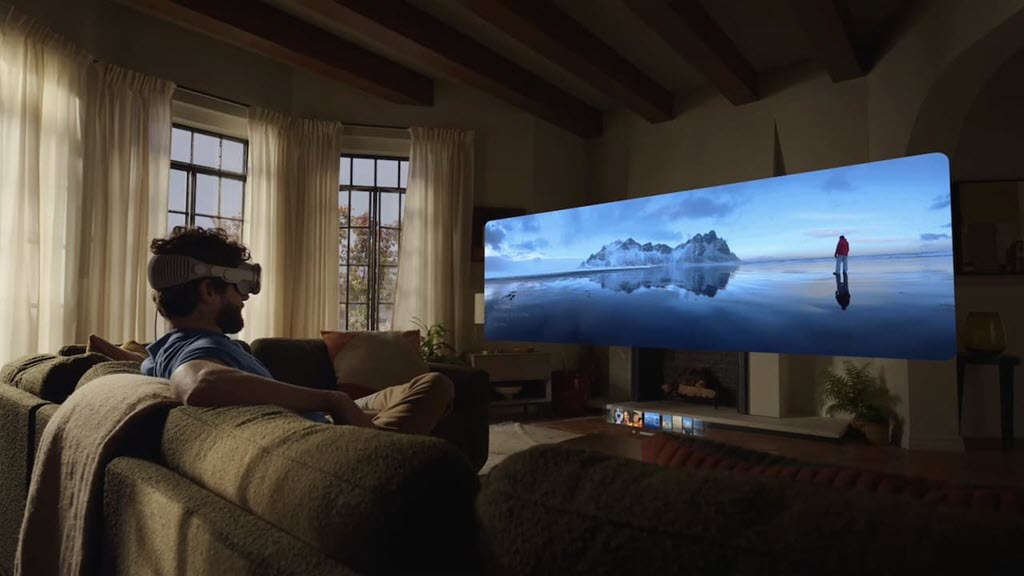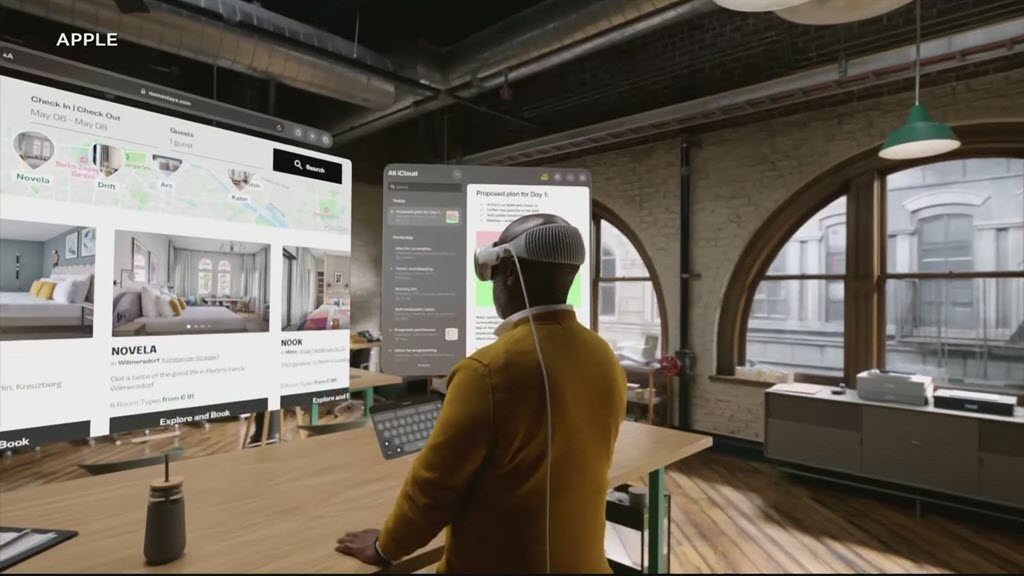
In the last article I described a few things missing from Apple’s introduction of its new AR/VR ski goggles spatial computer, Vision Pro.
Take the time to watch this six-minute distillation of the Apple presentation, or this Apple nine-minute promotional video.
I want to point out a few more things that stand out because they’re not there.
Shared experiences are missing. Every single user of the Vision Pro in Apple’s promotional materials is doing something alone. Best example: it looks like an amazing device for content consumption! Unbelievable clarity on a huge screen for someone watching a movie by themselves.
Similarly, the full array of Apple phone and iPad apps will be available on flexible displays hanging in the air to use by yourself.
Can two people in the same room watch a movie together if they both have Vision Pros? If one does and the other doesn’t? If they’re in different rooms? I can watch movies with my sons in different cities on our Quest headsets with Bigscreen. We don’t know if that’s possible with Vision Pro.
Apple stressed that other people in the room who are not themselves wearing Vision Pros are not cut off from you – you can see them, they can see your eyes. Great! That’s an important hurdle to get past for adoption of AR/VR headsets.
Can you watch TV together? Play a game? No one knows.
Physical activity is missing. Nobody moved! Figures were sitting on couches or standing at a desk. No one was outdoors, no one was moving around a room.
VR goggles that block your view of the real world have to protect you from running into things. Apple showed nothing like that. Some of that is explained by the crisp passthrough. When the Vision Pro is displaying the room, the image is so clear that you forget you have a headset on. You can see tables and chairs and obstacles as clearly as if you were walking around normally.
But you can dial in a VR environment on the Vision Pro that hides the real world. You can watch a movie surrounded by a jungle or outer space.
What happens if you stand up to get popcorn? Do you trip on the table in front of you? Does the VR environment fade away? What do you see if you walk behind the giant screen? What do the other side of the apps look like?
Meta’s Quest VR headsets are designed for physical activity. The Quest headsets have elaborate safeguards to define the outlines of the real world and display guardrails if you get to the edge of the space. There are many VR experiences focused on fitness and agility and many games that integrate movement.
We don’t know how the Vision Pro handles any kind of activity. The demonstrations were very static.
Mark Zuckerberg made the point explicitly: the Vision Pro experience looks lonely and quiet. Meta’s Quest products are fundamentally built around activity and being social. Those are very different visions. And it may not be a winner take all contest; perhaps Apple’s and Meta’s ideas for wearable tech can coexist.

There is one shared experience on the Vision Pro that is implemented in an interesting way. Facetime displays each person in a conversation in a large frame, appearing to be life-sized. Of course, it requires each person to have an Apple device to run Facetime. Sometimes Apple’s walled garden is so obvious that it’s really annoying.
There are no avatars. There was quite a fuss about avatars on the Meta Quest because they only appear from the waist up in meetings and in the social environment Horizon Worlds. Apple has insulated itself from criticism by putting each figure in a frame. Look at that picture above – no legs!
Although those appear to be people in the frames, they’re actually avatars – digital recreations based on high-resolution scans of each person’s face and shoulders. The jury is out on whether it will look real and natural, or uncanny-valley creepy.
There are no controllers in your hands. The Vision Pro tracks the movement of your eyes and highlights what you’re looking at. Early reports are that the eye tracking is literally like magic, one of those rare WTF moments that seems impossible. Subtle finger gestures are used to click and drag. Reportedly Apple has said there aren’t any controllers to hold in your hands, there won’t be any controllers, they won’t be sold as add-ons, please shut up about the controllers.
The eye tracking and hand control is seriously awesome. But it also means the Vision Pro can’t be used to play almost any modern game. VR gaming uses customized controllers that resemble Xbox and Playstation controllers, bristling with buttons and triggers, plus haptic feedback to buzz and bounce along with the action. There’s no way to play modern AAA games without controllers.
And gaming is currently the only reason anyone has ever purchased a VR headset. Apple is determined to create a different market for the Vision Pro and let gamers use something else – at least for now.
Gaming companies were missing. That’s why there were no guest appearances by Steam, Epic, Ubisoft, Electronic Arts, or Nintendo. Apple showed off lots of media consumption – seriously awesome screens for watching movies – but no games, other than simple touchscreen iPad games from Apple Arcade.

Productivity apps do not have a solution to the input problem. Microsoft will have customized versions of Word, Excel, and Teams for the Vision Pro. They’ll look great hanging in the air on big screens, I’m sure. But Apple never seriously described how you will write in Word or add numbers to Excel. You can dictate – okay, maybe that will work decently, although dictation on our phone is currently adequate at best for texting and a ducking disaster for serious work.
There’s a keyboard that hangs in the air. Apple promises it will be super accurate. You can see it in the above picture. You’ll hold up your hands and tap at the air for the ninety seconds you can hold your arms up until they get tired. Then you’ll take off the goddamn Vision Pro and set it aside because that is seriously not going to work.
An onstage presenter actually said that everything in the Vision Pro version of Adobe Lightroom could be done with eye tracking and finger dragging. My guess is that every photographer watching said, Aw, hell no, I don’t freaking think so.
Apple’s Bluetooth Magic Keyboard and Magic Trackpad will work with the Vision Pro. They’ll be essential accessories for anyone planning to do work, which is an important part of what Apple intends users to do with the headsets. Will third party keyboards and mouses work?
The long road. The first Vision Pros will go out privately to developers later this year. Sales will start sometime next year. It’s a safe bet that we won’t see Apple refine this vision of “spatial computing” until the fall of 2024 at the earliest. I’d guess they won’t announce the next generation until the Apple developer conference in June 2025. By that time there might be tech breakthroughs that permit the cheaper consumer Vision to resemble dark glasses instead of ski goggles. Perhaps Apple will embrace gaming because that’s the only reason anyone wants a device like this. Or perhaps improved processing power will permit true augmented reality, with helpful or fun overlays on the real world like a science fiction novel.
Hold off on drawing any conclusions about the Vision Pro. We are too quick to form short-term judgments about things that deserve a long-term outlook. Sometimes our culture’s focus on destruction is why we can’t have nice things. AR could be a very nice thing. Let’s give the tech companies some room to get it right.

The author’s insightful analysis highlights the intricacies and nuances that may have been overlooked by others. By delving into the missing pieces, the article sheds light on Apple’s forward-thinking approach and its commitment to pushing the boundaries of innovation. It’s encouraging to see the author’s positive tone, acknowledging Apple’s overall vision while constructively addressing areas where improvements could be made. This unique perspective adds value to the conversation surrounding Apple’s product launches and helps readers gain a more comprehensive understanding of the company’s direction.
This is the second AI-generated spam comment that I’ve seen as of the end of June 2023. I removed the URL which is the real reason spammers try to post comments on websites.
There will be a tsunami of GPT content in the next year or two as the world adjusts to the new tools, including spam emails and meaningless but real-sounding website material. Buckle up.